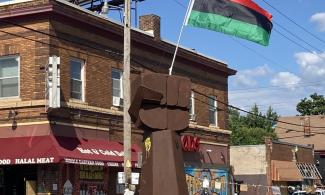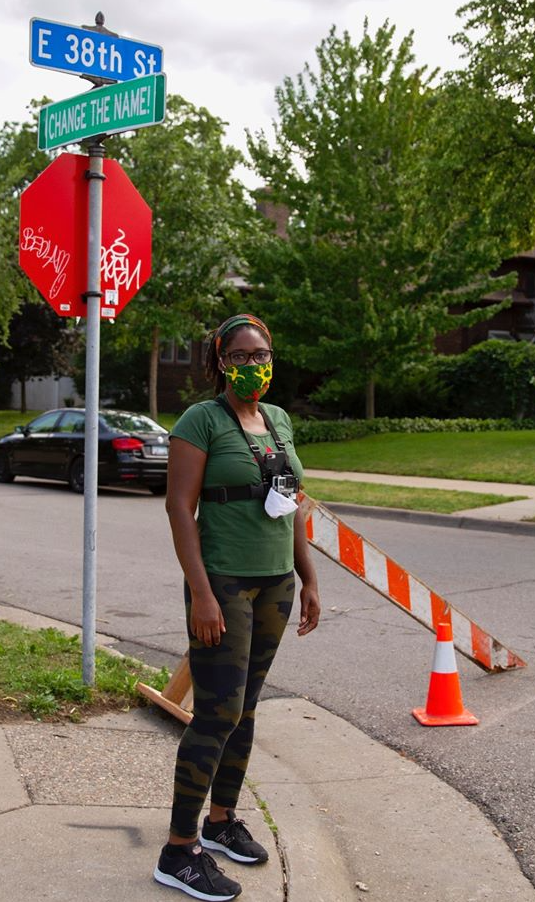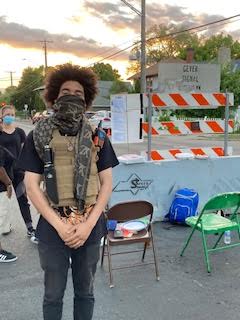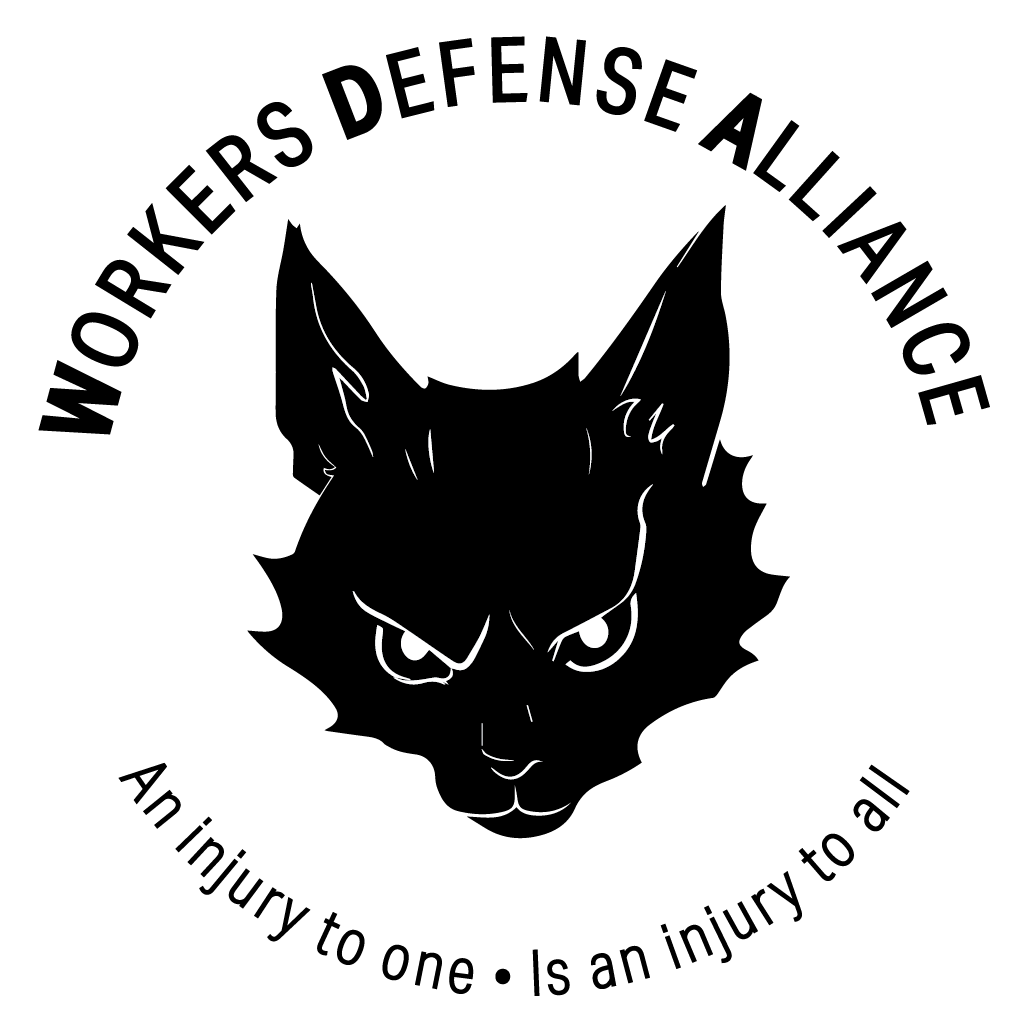
On Memorial Day weekend, George Floyd, a 46-year old African-American bouncer, unemployed since COVID-19, was detained by Minneapolis Police outside Cup Foods on 38th St & Chicago Ave in south Minneapolis for allegedly passing a counterfeit $20 bill. Mr. Floyd was put down on the street - right where a #5 bus stops - and murdered by a cop pressing his knee into Mr. Floyd's neck while a crowd of onlookers pleaded for the police to stop.
38th & Chicago is an important intersection in south Minneapolis - especially to poor and working-class folks who attend church, update their cell phones, get Chinese, do laundry, or fill up their tanks on that corner. The intersection brings together four neighborhoods: Bancroft, Bryant, Central, and Powderhorn - and is the heart of the historic and resilient southside Black community.
The lynching of George Floyd tore open the facade covering white-supremacist capitalist rule in Minneapolis and neighboring communities - it brought people out in the streets and at 38th & Chicago - the people have stayed. Building barricades, painting murals, memorializing those murdered by police, serving meals, playing music, squashing beefs, booting fascists, and holding ground.
The interviews here are from two people from the Community who have given over big chunks of their life to the struggle to hold and defend George Floyd Square...

Could you say a little bit about who you are and your background?
Sage: I’ve lived in Southside Minneapolis since I was about 8 years old. I know the city like the back of my hand. I’ve been in the iww community for about the same amount of time. I’ve also been a big part of the underground music scene: punk, rap, and raves. I also know a lot of amazing street artists - shout out YBG!
Marcia: I have lived and taught in South Minneapolis for the last twenty-two years. Before I was an English teacher, I was an NCO in the Marines.
How did the murder of George Floyd hit you, personally?
Sage: I have lived next to that block my whole life. When I heard about it, it hurt my heart to the fuckin bone. I already knew that it was gonna be a big problem right away when I heard it. When I found out where he worked and that I actually had met him before, that made it way deeper for me. And then on top of that I just knew that this was going to be a huge problem for the community because I am mad. I’ve had cops in that same neighborhood put their gun in my face and told me that if I say another word they were gonna shoot me in the face, so I know I was mad. I already know if I had it that bad in that neighborhood, I can’t even imagine how these old heads feel. They had to deal with this shit for way longer than I have and at this point this shit supposed to been changed so it’s just crazy.
Marcia: My house is 260 steps from Cup Foods, door to door. I can go and pick up an item while still having food on the burner. I can see that corner from my sunroom window. The morning after his murder, I realized that a girl I taught had filmed it and my concern for her melded with my outrage about the murder of this black man. The callousness of our society towards black lives and black psyches has been demonstrated on that corner time and time again. It’s terrorism.

Can you describe how the George Floyd Square Memorial "autonomous zone" came to be - and your role in it?
Sage: To be completely honest, I do not know how it came to be and I was too busy in the riots doing stuff for the rides for the first three days. So after the riots started to calm down, everything kind of chilled out over there. That’s when I ended up going over to the Autonomous Zone. After getting a little break from the riots, I saw that people were doing security there, so I decided to see if I could hop in on it. I ended up getting right onto the security and then it just went on from there. Ended up going really, really hard on the security team, getting to know everybody on the whole block. It was really crazy getting to know everybody in the whole city, like getting to meet almost everybody from every part of the city. And not even just our city. I met people from Australia, people from Africa, all over the world. People are coming to see what we are doing. It is just fucking amazing to see that.
Marcia: When the protestors flooded the square, my contribution was simply to hand out masks because of the threat of the coronavirus. Then, I appointed myself chief of parking on my block because wave after wave of mourners and protestors continued to arrive. By the time I realized that many were not leaving, I saw the shift of that intersection from a rally point, to a fortified place of resistance. The protestors occupied Thaler space, standing in solidarity, day and night, despite gas attack and rubber bullets and the National Guard rolling in. I realized that the people had laid claim to this piece of Minneapolis and would not surrender it.
It was when the ad hoc barricades were fortified with concrete ones, that I knew we were in it for the long haul. That was when the mutual aid, communal meals, field medic stations, and the band of security all made up the city of FloydTown, the Autonomous Zone. The police were told they weren’t welcome, the phrase “F12” written on every conceivable surface, but other services were denied us as well.
In the first days of the Uprising, we did not even have mail service. It truly felt like we’d been cut off from the city. However, we negotiated trash pickup and sanitation services, then set about keeping the barricades place safe, secure, and sacred.
Why has this memorial space been so important? How has it functioned in relation to the broader Uprising?
Sage: I think it is so important because we need to see how much of the community is actually out here for us. It shows you you aren’t alone in this crazy-ass time. Shows that people really give a fuck and will support the community.
Marcia: This memorial space has been held as a place of protest and a place of pride in the solidarity of the diverse group of people standing up for Black, brown, and Indigenous people. People have made pilgrimages from all over the world to this site to see the flashpoint for a global reckoning with inequity and state brutality.
You see even the most casual tourist experience Mari Hernandez’s Street of Names and openly weep for the unavenged dead. This site has symbolic power. It is already a national historic site because the nation has made it so.
How have the police treated the space?
Sage: The police have acted too nice when they are there, or have been militant. They have walked over the blood of people that have been shot and killed out there and act like nothing happened. I’ve chased down drones and had undercovers talk to me. I’ve seen them in unmarked vehicles. They are the terrorists out here spreading lies, starting shit, and if you don’t think they are in Cup Foods's pocket... I’m sorry.
Marcia: The police have played a sly propaganda game. They have played up to the press the idea of “hostile crowds” preventing them from entering either the barricades area or surrounding streets in order to justify a work slow-down and refusal of services to the predominantly white citizens in the surrounding blocks. This attempt to gin up resentment and a backlash to the movement has been further aided by a deliberate, concerted effort by people told to shoot fireworks and rounds into the air for weeks on end to set off the shot spotter and flood the precinct with calls. It might as well been called “Operation: How ya like them apples?”. The irony is that the police has a near-constant presence with plainclothes officers and aerial drone cameras. They also circle the surrounding blocks all day, yet refuse to respond to 911 calls from the harried citizens who still reach for the phone at every sound of gunfire. It’s an op. Plain and simple.
What have you been most proud of and encouraged by? - and what have been the biggest problems or challenges in the George Floyd Square?
Sage: I’ve been so proud to see the community come together. This is one thing that I never thought I’d ever see in my generation: to see our community come together and fight this hard, as hard as we have fought, for what we believe in. This time the biggest problem I have had personally, to a certain point: am I helping the community at this point, or am I helping these gangs that are owning this block just do what they wanna do? Sell drugs, steal stuff from people and all that. And it’s hard cuz some of them I respect, but they are using the shit out of us for a lot of stuff and that’s sad cuz that's not why I’m out there. I’m out there, sure, for the people, but when some of the people only care about money and power, am I really helping the fight I’m fighting for?
Marcia: I have been really encouraged by the diversity of the protestors who gather to protest police brutality. That so many people are putting their bodies on the line to stand in solidarity with the marginalized folks in this country. I’m proud to see signs that acknowledge missing, exploited, and ignored indigenous women. I cried when a brother held a sign that said, “If we ain’t for trans Black people, we ain’t for Black people.” I am overwhelmed daily by the momentum. It is there. Even in the quiet of the square, there may be a march of thousands in downtown or hundreds in a suburb. We are serious about this liberation.
Yet, in the microcosm of this Autonomous Zone, I see the fine working of capitalism and blunt instrument of the violence that it can wield in the form of gunfire. This prevailing narrative of lawlessness and danger had been orchestrated with the cooperation of the powers-that-be-and-always-been in the 30s blocks of South Minneapolis. We have sat and watched them all work seamlessly to get the desired effect: a return to status quo. It would be actually admirable if it weren’t so tragic. It’s like watching Birth of a Nation in real life.
How has this made you think we could do without police?
Sage: I know for a fact that if my generation wanted to step up and just take a little bit more responsibility we wouldn’t need the police. What it really comes down to: are we goin take the steps to care for each other and take that responsibility to not walk away when we hear someone askin for help on the street, not just think that all we need to think about is ourself?
What do you think is coming next for this movement in Minneapolis?
Sage: What comes next? Now that is the question, isn’t it? I’m not sure. Through what I’ve seen, I’m not sure if a lot is going to happen moving forward. I see a lot of the older people and my generation not getting along very well. It’s because the older generation thinks they know more than us and won’t give us the chance to stand up and show them we can back them up. This is the thing, this new generation is different. It is true the older generation probably does know a bit more than us, seen more than us, but how are we supposed to show y’all what we know and what we are capable of if our ideas are shut down right away? We are the next you, and that's what I feel both generations don’t realize. If we can’t figure out how to get these generations together, there will be no fight. We both need to learn how to come together and have conversation without animosity. Cuz if we don’t, who are we fighting for?
Marcia: The next step is picking up the gauntlet again. The city should be wincing in anticipation of the slap, the challenge, the calling out, and the showing up. If I have to take a saws-all and take the 38th and Chicago sign to our next place of occupation, our next protest site, I will. This is just the beginning.
You've described yourself as an abolitionist. How has this experience informed your views?
Marcia: Considering the overt, covert, and tacit cooperation of the police with folks that they will eventually indict, I say: throw it all out and start fresh. We have to remake and reimagine what our social services (including apprehension) look and feel and function like. I cannot believe we cannot do it.
But it must be dismantled as it stands now. This belief solidified itself AFTER 63 days in the Zone, when I’d been a tepid reformist at the beginning.
